Media Power of the Digital Outdoor
The digital out-of-home (DOOH) advertising continues to grow fast. The number of digital networks doubles every year, the operators of traditional outdoor advertising are busy transferring to a new digital platform, the number of international fairs and exhibitions dedicated to DOOH are now conducted in nearly every country of the world.
Analytical resources, including our Journal, have invented how to call digital outdoor advertising – a new media or outdoor TV. But can we honestly call it a media? Is DOOH so mature as we wish it to be? Let us try to see where it stands.
Let us begin with the positive trends. What is the current status of the digital outdoor advertising? First of all, the technology is sufficiently mature and stable across the industry: in the area of LED outdoor screens and LCD screens for out-of-home usage (public buildings, commercial centers, transport). The outdoor advertising has drastically changed: modern outdoor advertising is inconceivable without video clips of high quality displayed on screens of excellent resolution.
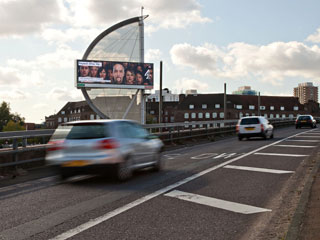 |
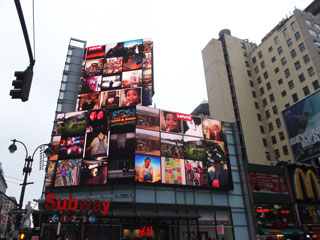 |
| The advertising LED billboard in London that belongs to JCDecaux Photo credit: screengallery.co.uk |
Three LED SMD screens manufactured by Barco in New York Photo credit: dailydooh.com |
Moreover, the competition among manufacturers of electronics (in China and Korea) resulted in significant price reduction on digital carriers (for example, the price of one square meter of a LED screen dropped from several dozens of dollars to 1-5 thousand depending on the resolution and LED quality). Thus, today digital outdoor screens became affordable and are currently produced in all possible formats to suit all business models (from seamless LCD monitors to LED screens of any shape and form).
Today hundreds of digital networks (local, regional, international) are in operation around the world. As a result, the budgets are being redistributed in favour of the emerging new digital carriers. The growth rate of DOOH is second only to the Internet-based advertising. When planning an advertising campaign or introducing a new brand or a product line no manufacturer will do without digital outdoor advertising.
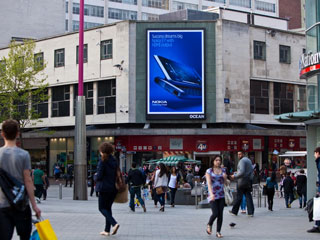 |
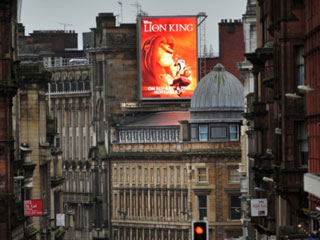 |
| The advertising LED screen Ocean Outdoor in London Photo credit: Ocean Outdoor |
The advertising LED screen Forrest Media in Glasgow Photo credit: screengallery.co.uk |
All of the above is a clear indication of the constant growth of DOOH segment in the marketplace. DOOH is strengthening its grip on advertisers and market experts alike. However there still remain many obstacles that have to be taken into account when planning a new media business or expanding the one that already exists.
Any digital advertising network requires sophisticated software that would control the screens, make the broadcasting schedules, generate reports, adapt available advertising clips to screens of various formats. However the market is currently overloaded with software solutions – and only few specialists are capable to sort through hundreds of available specialized programs and select the optimized version. A number of large outdoor operators decided to develop their own software platforms and this approach hurts the already badly fragmented market.
One more complication is the offer of some software developers to small and medium-sized advertising companies to transfer the control over their networks to the cloud storage (networked online storage where data is stored in virtualized pools of storage which are generally hosted by third parties). The seeming simplicity and low price of such solution is scaring away many potential users who are not ready to relinquish control over their resources to outsiders. Moreover, the wrong choice of a software package may bring along serious losses when the operator finally decides to move over to a better business platform.
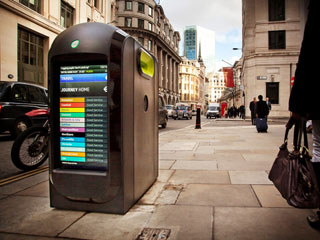 |
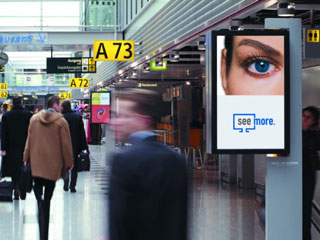 |
| One of the 200 LCD kiosks (combined with waste paper storage) installed by Renew in London Photo credit: renewsolution.com |
The NEC advertising LCD screens in 2-nd Terminal of the Heathrow Airport in London Photo credit: digitalavmagazine.com |
Another factor that makes life for advertisers difficult is the need to prepare video clips for digital networks. Adapting video materials specially prepared for TV broadcasts is not always an easy way out. Perception of video materials outdoors drastically differs from perception in a relaxed atmosphere of your at home. Therefore, the structure of video materials for outdoors must be different. But so far there are no clear guidelines or industry standards of how this should be done. Luckily the choice between dynamic video and static slide advertising is naturally resolved in favour of the former. However drawbacks and limitations are still numerous:
- First, following the expansion of TV video standard, LED outdoor screens are gradually moving in the direction of wide format and instead of traditional 3:4 ratio, more and more new screens appear in the format of 9:16. Then should advertisers make video clips to cover the whole area of the screen, or use the multiple screen or split-screen option? Another debatable issue is the length of the advertising clip and loop: in different networks the length of the clip varies from 5 to 15 seconds depending on the scheduling in that area. Thus, how many clips should one prepare?
- Secondly, it is not clear whether outdoor screens need audio support or not. Consumers are used to video and audio presentation, but in the street audio may only spoil the impression due to overwhelming street noise.
- Thirdly, it is not clear how to treat the issue of social advertising? In some cities, authorities insist on receiving a “quota” of time in each loop on all digital screens or on some total time quota over a month. On the one hand, social and informational inserts add to the total value of the screen. They “dilute” commercial advertising with something interesting or useful. On the other hand, this practice leads to financial losses and extends the ROI cycle for screen operators.
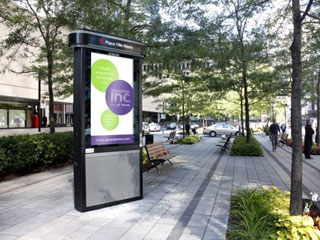 |
 |
| The network of LCD stands belonging to Astral company in Canada Photo credit: ooh-tv.com |
The advertising LCD panels in Marks&Spencer store in Manchester Photo credit: ooh-tv.com |
A decision to start advertising on digital network must be based on clear criteria of technical data and financial efficiency. However, fragmentation of networks, absence of verifiable information about the potential audience (size of the target audience, social and demographic parameters of the audience etc.), price and discount wars (especially when digital screens are different in size and format), absence of standardized feedback and reporting – all this turns the decision to advertise on digital networks into a difficult and painful process. It is this lack of standards that prevents digital outdoor advertising from becoming an independent media and from entering the mainstream of the advertising market.
The operators of digital networks are trying shift the balance by introducing new technological innovations: eye-counting or car-counting video cameras, other objective methods of audience evaluation. Additional ways of attracting attention to outdoor screens include social advertising and useful information on displays, interactive methods of communicating with an outdoor screen, dedicating screens to one specific brand and decorating them accordingly etc. However, all these attempts remain uncoordinated individual approach to prove the efficiency of the new media and determine its ROI level more or less accurately.
It turns out that today we deal with conflicting tendencies in outdoor digital advertising: its continuous growth, on the one hand, and segmentation of existing networks, the absence of unified standards and approaches within the industry – on the other. As a result, the digital outdoor advertising cannot acquire a coveted status of media and continues to struggle and compete with the traditional outdoor. But the continuous and steady growth of the digital outdoor advertising points out that the final choice will be made in its favour. We just hopes that it would happen soon!





